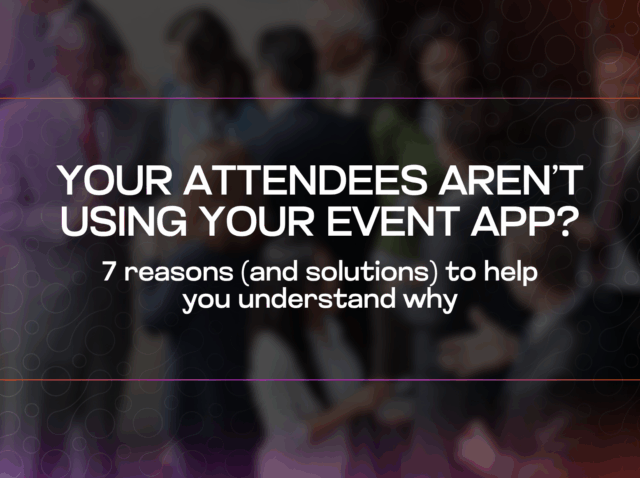For many event planners, hybrid events are still a relatively new challenge — one that requires engaging two very different audiences at the same time. Here are 13 expert tips to help you avoid the most common pitfalls and ensure your next hybrid event runs smoothly.
While hybrid events offer the perfect solution for both in-person and remote participants, they also introduce new complexities. Meeting the expectations of a single audience has always been demanding — now, organizers must cater to two distinct groups, each with unique needs and preferences.
Let’s look at the 13 most common mistakes to avoid when planning your next hybrid event.
1. Choosing the Wrong Platform
The success of your hybrid event depends largely on the hybrid event platform you choose. It must include all the essential features to support both physical and virtual participation — such as a mobile app for onsite attendees and a desktop version for remote users.
Your platform should also enable smooth interaction between speakers and audiences, while offering advanced analytics to track engagement, polling results, session duration, and feedback.
Platforms like LetzFair are designed specifically for this purpose, offering comprehensive tools for both virtual and onsite management.
2. Skipping Tests and Rehearsals
Testing your virtual setup is just as important as preparing your physical venue. Every digital tool — from streaming software to lighting and audio — should be tested in advance to ensure a seamless experience for remote attendees.
3. Inadequate Infrastructure
Before launching a hybrid event with simultaneous live streaming, make sure your venue has strong and stable Wi-Fi. Many organizers overestimate their bandwidth capacity, leading to poor streaming quality and frustration among remote participants.
4. Treating Both Audiences the Same Way
While connecting your virtual and onsite audiences is important, not every session or activity will appeal to both. Tailor some content specifically for each audience segment by using a platform that supports customized agendas and separate communication channels.
5. Ignoring the Role of Virtual Hosts
Keeping remote attendees engaged is crucial. Consider hiring a virtual presenter who acts as the voice of your online audience — moderating chats, collecting questions, and relaying them to speakers to maintain interaction and inclusion.
6. Poor Event Marketing
When promoting your event, clearly communicate that it’s hybrid and highlight what each audience type will experience. As your event goes live, publish engaging social content and consider using paid ads to boost attendance and awareness.
7. Untrained Speakers
Speakers used to live events may struggle to engage remote audiences. Likewise, those experienced in virtual settings may find it difficult to balance both. Provide training so speakers can effectively connect with hybrid audiences using dynamic communication and visual cues.
8. Overly Long or Diluted Content
Lengthy sessions might work for in-person events but can quickly lose virtual viewers. Keep your content concise, visually appealing, and interactive. Use creative slides, polls, and Q&A moments to maintain engagement across both formats.
9. Overloaded Agenda
Virtual attendees generally have shorter attention spans, especially when viewing from home. Avoid long, back-to-back sessions. Instead, design shorter, focused sessions over multiple days, and include regular breaks and networking opportunities for both audiences.
10. Overlooking Sponsorship Opportunities
Hybrid events can attract larger audiences than purely physical ones — making them highly appealing to sponsors. Offer digital sponsorship packages with banner placements, video ads, sponsored sessions, and dedicated sponsor pages on your event website to maximize ROI.
11. No Post-Event Follow-Up
Make all your recorded sessions available on-demand after the event. This helps attendees revisit valuable content while serving as promotional material for future events.
Also, send follow-up emails, share event highlights on social media, and encourage online participants to attend your next in-person edition. Post-event marketing is essential for maintaining momentum and growing your community.
12. Ignoring Networking for Virtual Attendees
While in-person networking happens naturally, online participants need dedicated opportunities to connect. Provide virtual breakout rooms, chat spaces, and moderated sessions to help remote attendees interact.
You can also integrate social media channels, real-time polls, and virtual business card exchanges to foster engagement. Ideally, both in-person and remote attendees should use the same networking platform to connect seamlessly.
13. Inflexible Registration
With travel restrictions and changing circumstances, flexibility is key. Allow attendees to easily switch between virtual and in-person participation. Similarly, offer customizable agendas so participants can choose which sessions to join — a crucial feature for remote users.
Conclusion
Hybrid events present exciting opportunities but also come with challenges that can undermine success if not properly managed.
Platforms like LetzFair simplify hybrid event management by handling the virtual component for you — helping you avoid costly mistakes and deliver a flawless, engaging experience.
If you’re planning your next hybrid event and still deciding which platform to use, request a demo with LetzFair today to discover how it can help you create seamless and successful hybrid experiences.







